Published: 25th March 2024 | Author: Tanya Russell
When it comes to sculptures in the art world, there are a vast amount of material choices that exist for their creation. Similar to Foundry Bronze, Spelter is a common material that has been used for sculptures and decorative objects since the 19th and 20th centuries – its popularity originally deriving from its affordability compared to Bronze. Despite the initial challenge of distinguishing them apart with the naked eye, there are notable differences between the two.
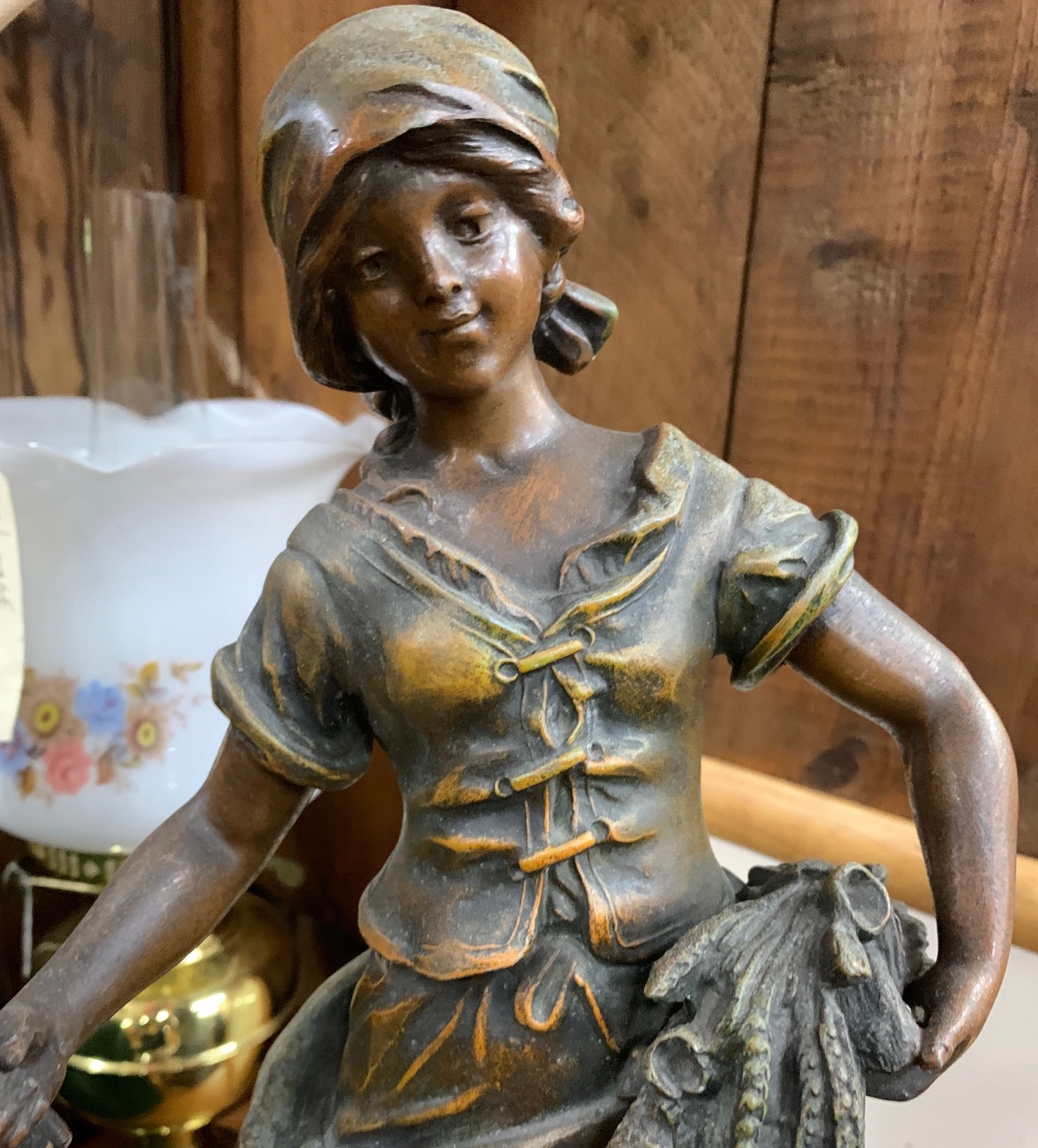
Above: Spelter statue with imitation bronze finish
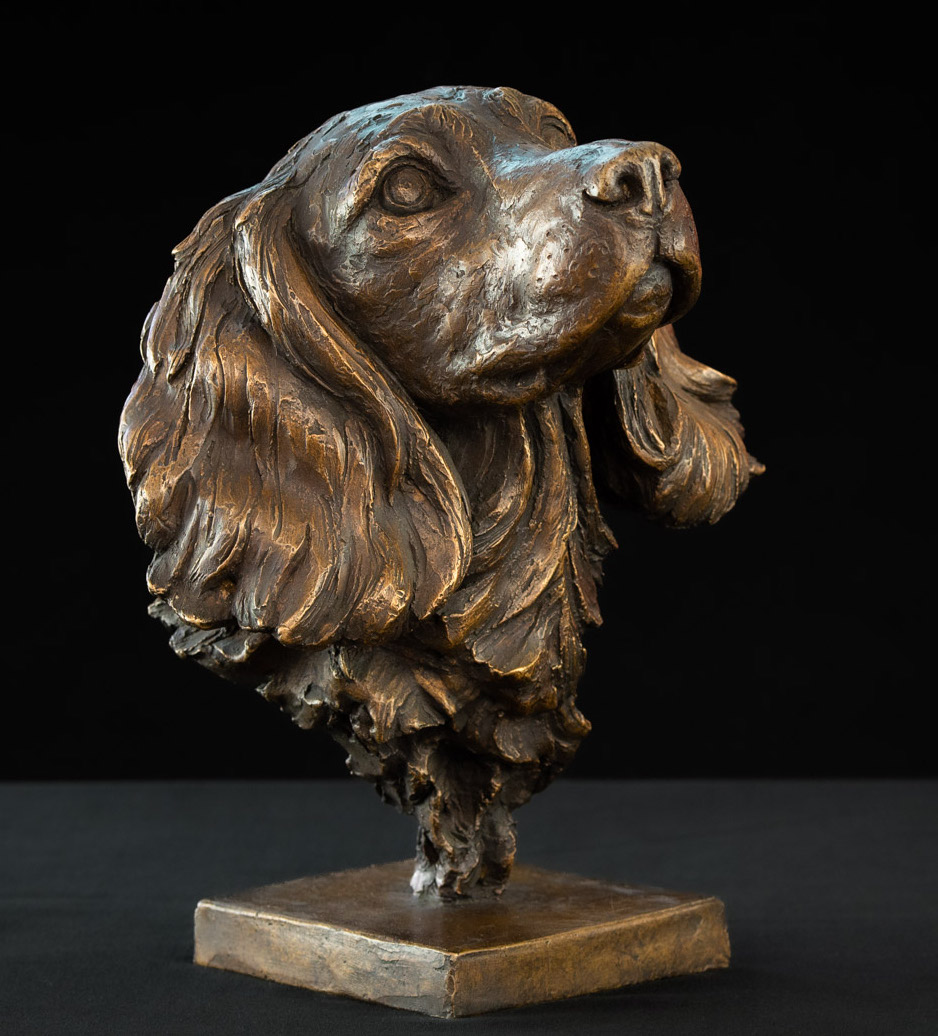
Foundry Bronze metal Spaniel Portrait statue
The material differences between Bronze vs Spelter
To start understanding their differences, it’s important to understand the differences in their makeup and properties.
- Both are metal alloys (metals combined with other elements), with Foundry Bronze being a high Copper and low Tin mix, versus Spelter being either a high Zinc and low Copper mix, or high Zinc and low Lead mix. There is no fixed proportion, though Foundry Bronze used for statues usually has around 85-95% Copper, compared to as low as 2% Copper in Spelter, climbing higher for better imitation alloys.
- Spelter is cheaper than Bronze, due to its low (or zero) Copper content. This is the reason for it’s frequent identification in the antiques market as a ‘pot metal’. Spelter was a popular material for candlesticks, lamps and in the mid 1900’s, art deco and art nouveau figures. Spelter commonly appears as an, often painted, imitation of the more expensive Foundry Bronze.
- Both Foundry Bronze and Spelter can be used to make statues. Bronze is much less commonly found in utilitarian objects that are likely to have been produced in volume, and is not often found in lamps and tableware.
- Spelter is softer and more brittle than Foundry Bronze and as a result, artwork made from it is fragile and can be easily damaged. Spelter is usually also cast thinner, which also contributes to its relative fragility.
- Bronze has a higher melting point than Spelter, so it is a little harder to make (though less toxic in the case of a Zinc-Lead Spelter), which also contributes to cost.
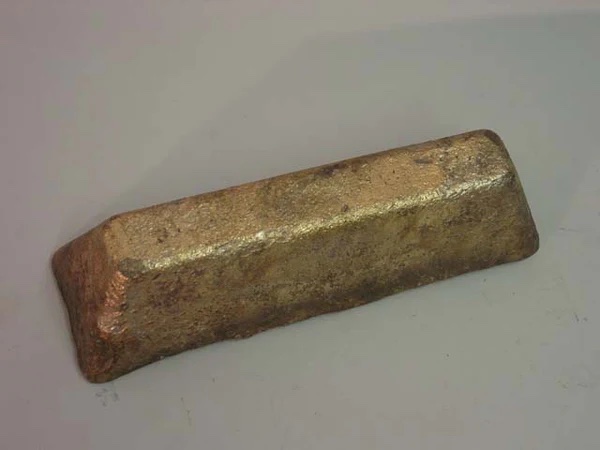
Above: A Silicon Bronze ingot – made with Copper and Tin
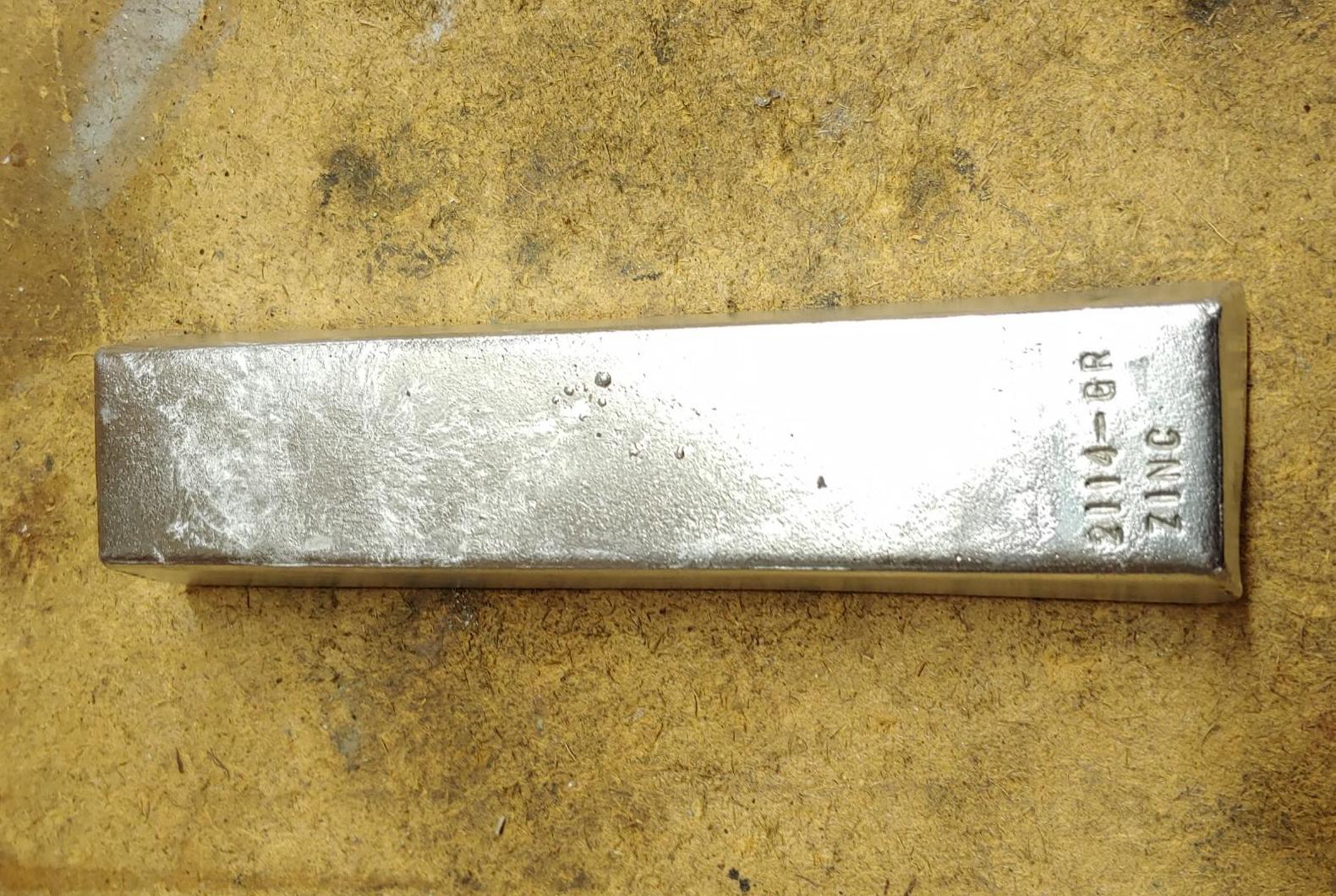
Above: A Zinc ingot – which can be mixed with Lead or Copper to make Spelter
You can read more about how bronze is made and the process of creating bronze for sculptures in our article on the bronze making process.
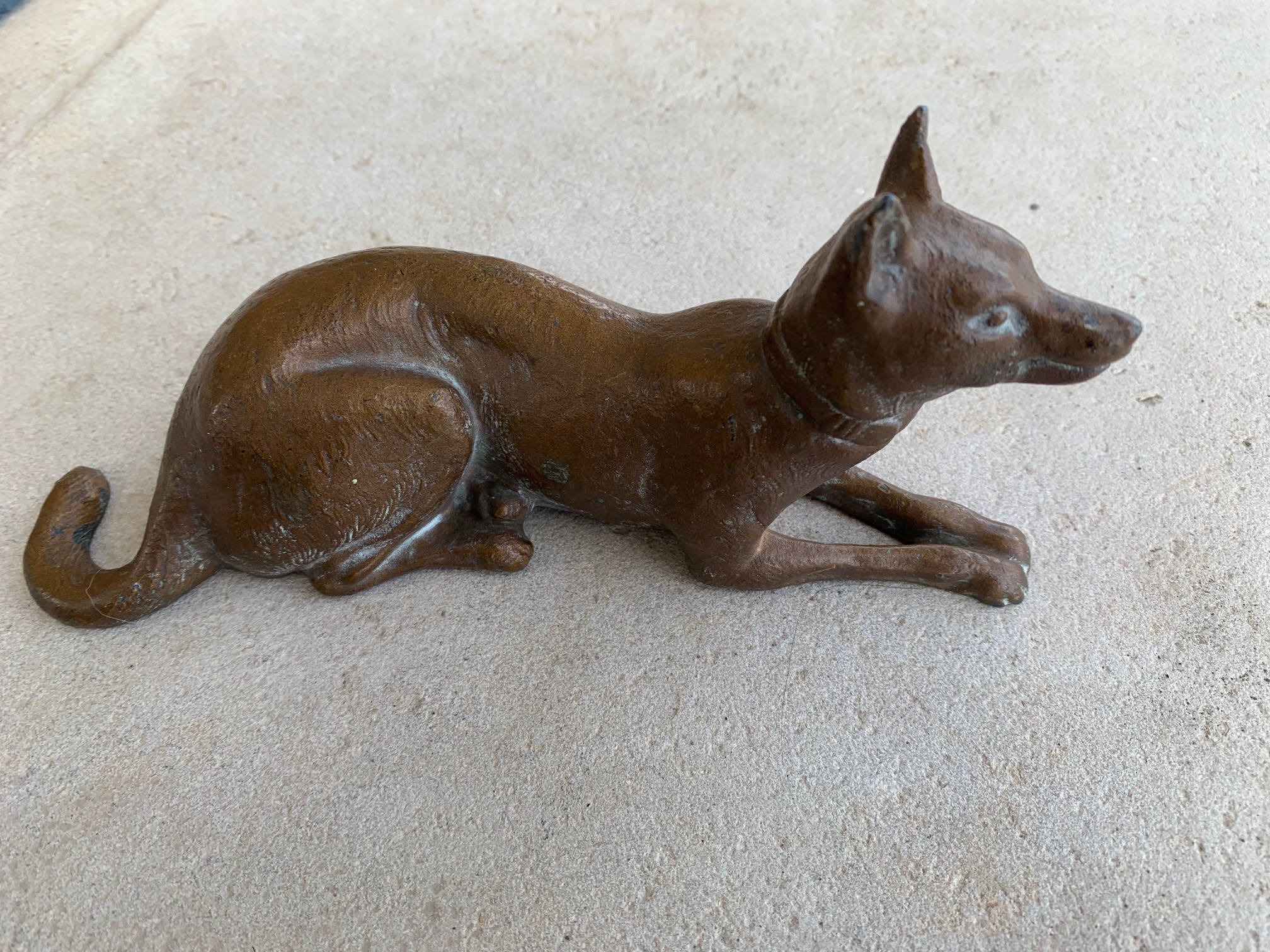
Above left: Spelter statue with imitation bronze finish, showing lower quality detailing. Poor detailing isn’t always synonymous with Spelter, some are excellent, but as the cheaper material, it is more likely to also be more poorly sculpted.
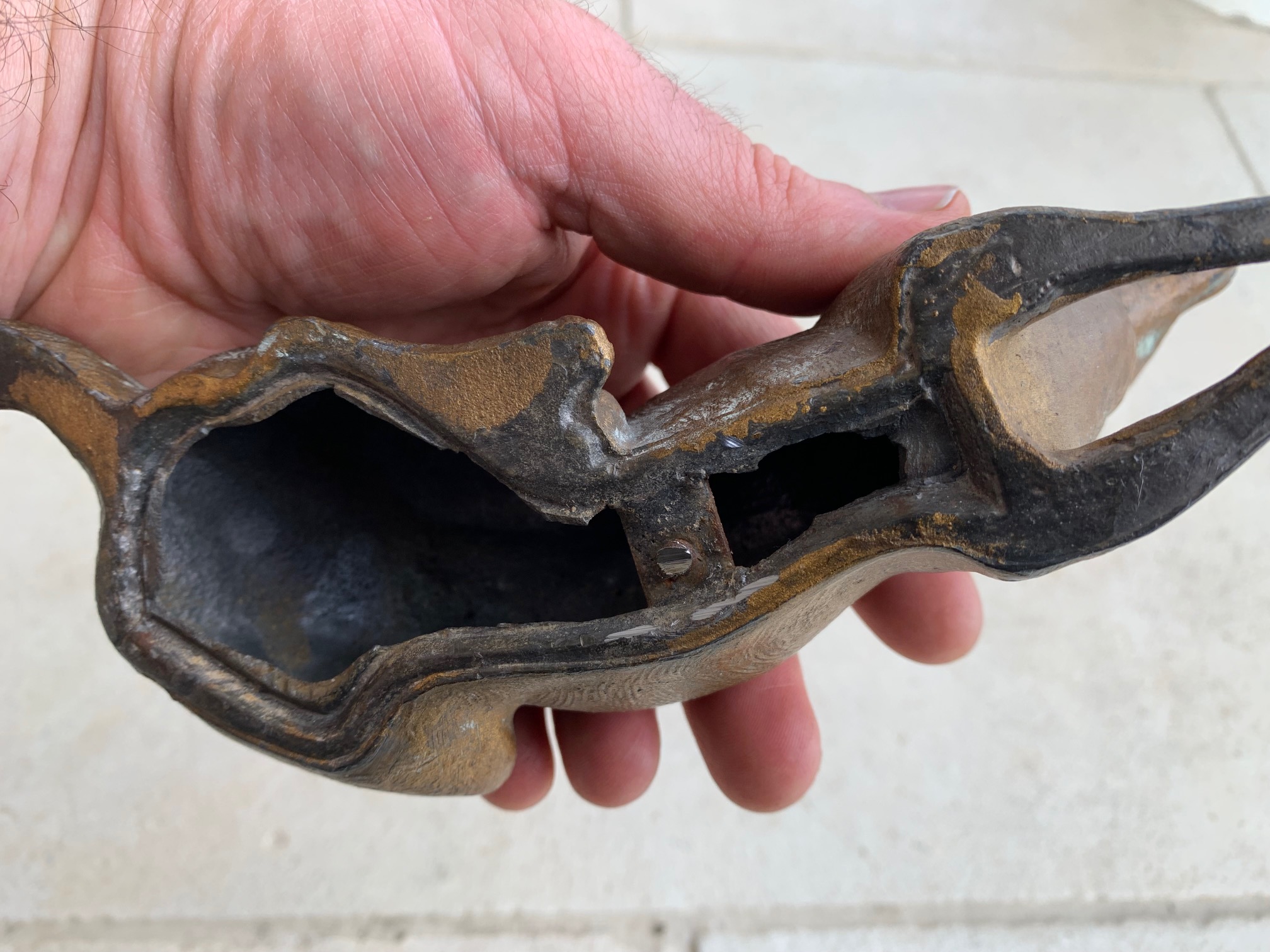
Above right: Turning it over, you can see the interruption of the painted surface. Additionally, this is hollow, where a small sculpture this size made in Bronze would probably be cast solid, which in this size would weigh more than this Spelter dog.
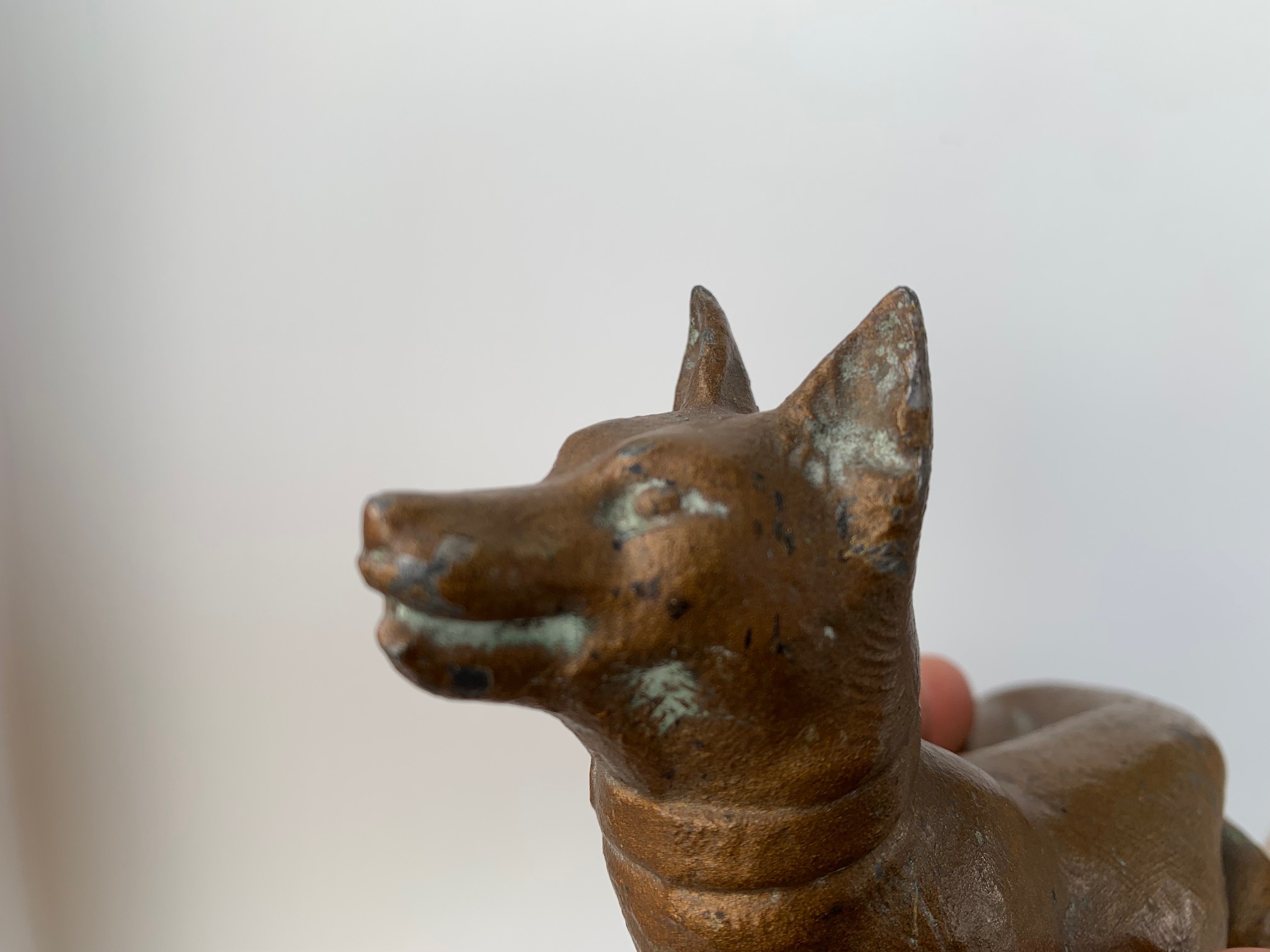
Above left: Corrosion of the zinc alloy, visible on the ears and around the mouth ears and cheeks. Bronze is far more resistant to corrosion by comparison.
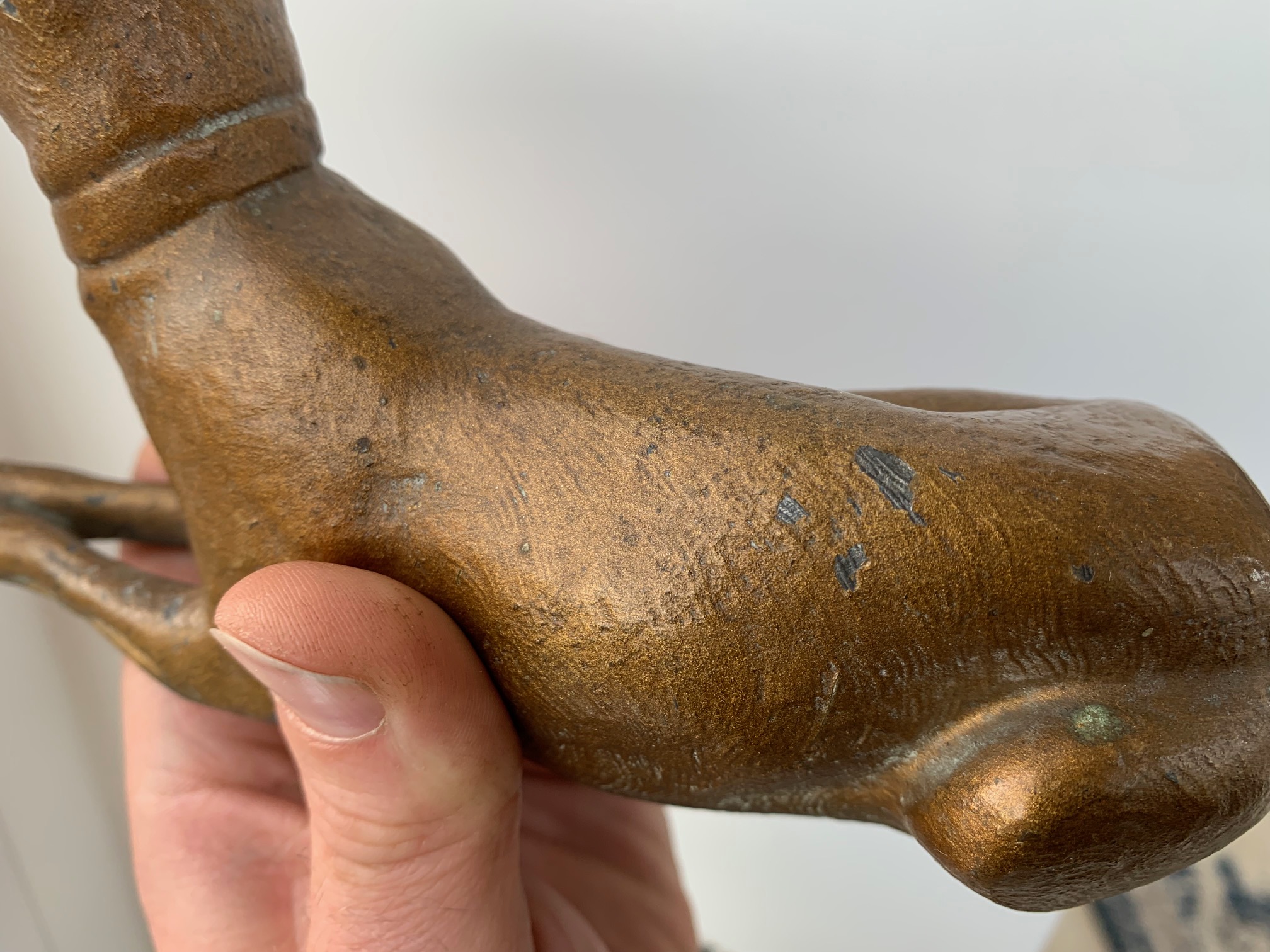
Above right: Chips like these show that the Spelter statue has a painted finish, and not the patina of a Bronze which does not chip (but can scratch).
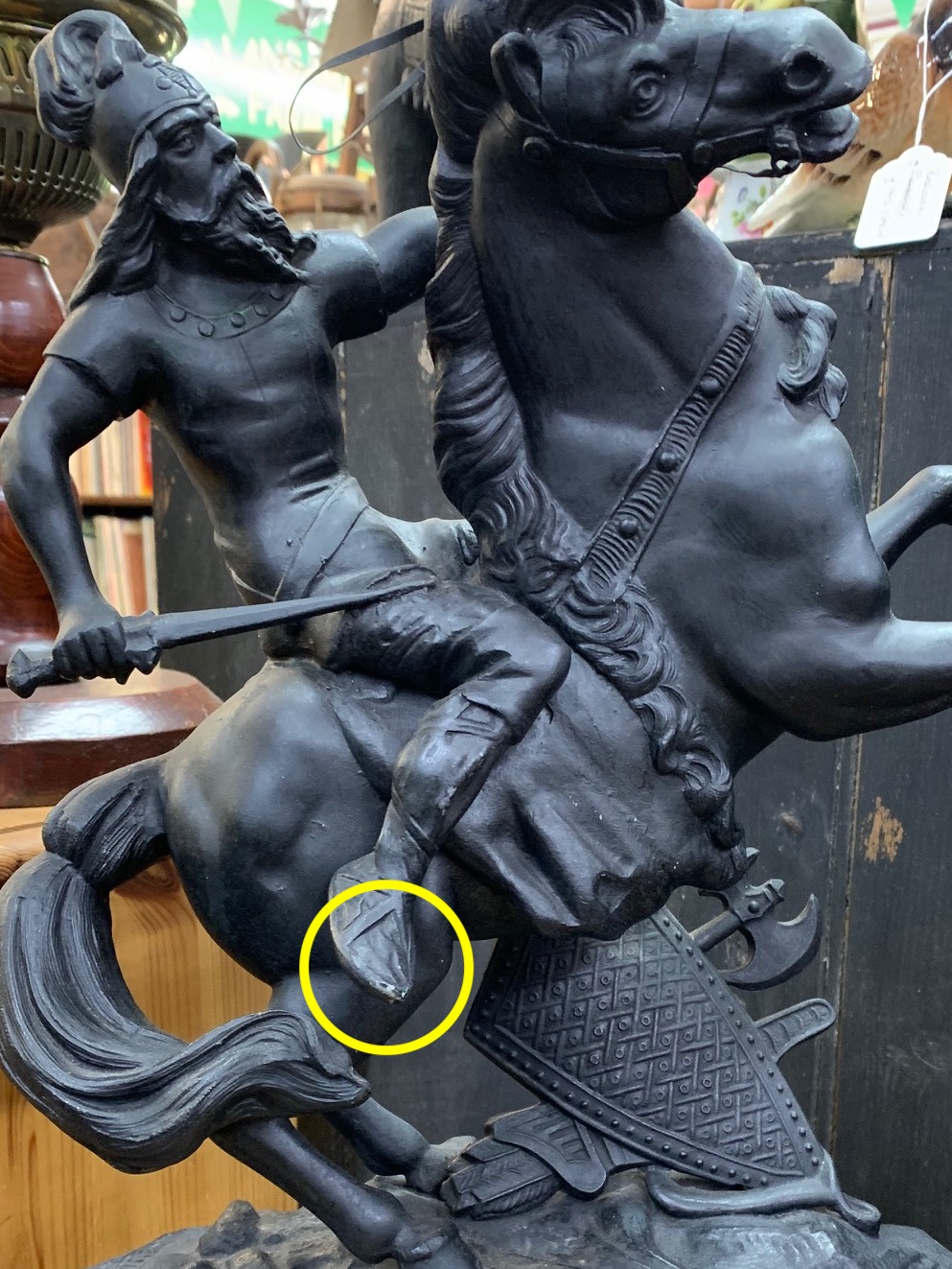
Above: A Spelter statue with a black finish – likely a painted surface. This is not unlike a black patina Bronze (a lot of antique bronze is black, often due to lack of maintenance).
Below: A black patina Foundry Bronze metal cat ‘Robert the Allotment Cat’
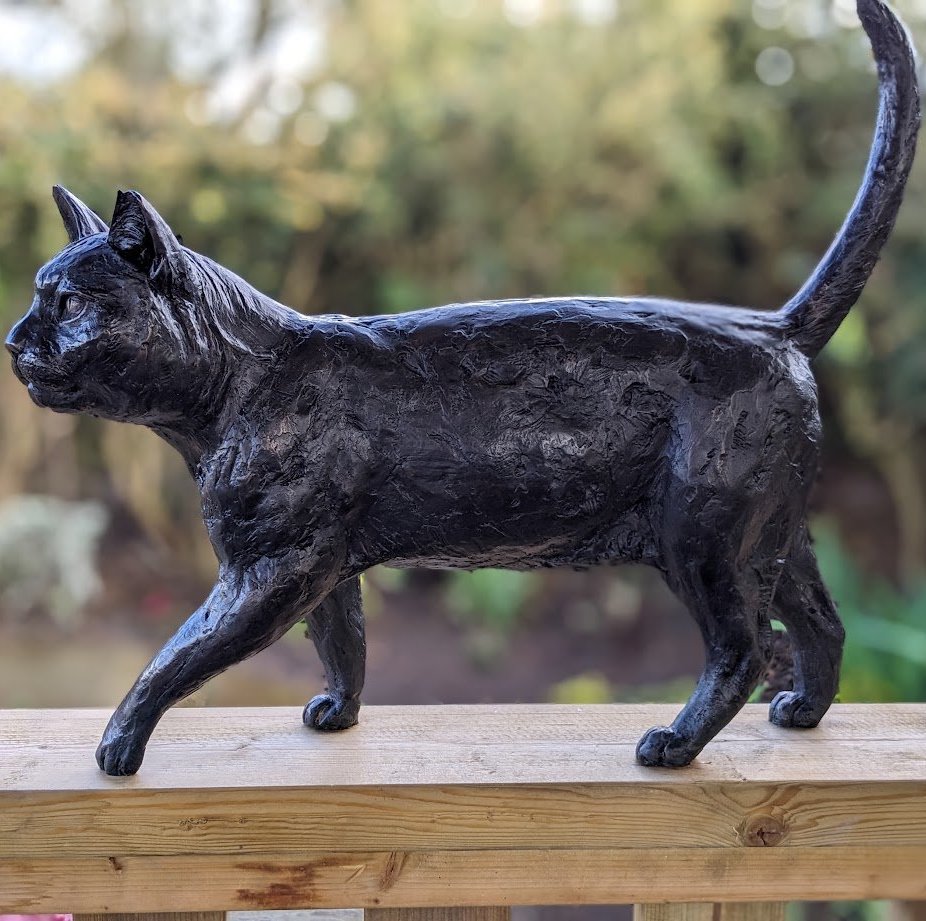
Below: The bottom of a Spelter statue. See the silver scratches showing the zinc alloy.
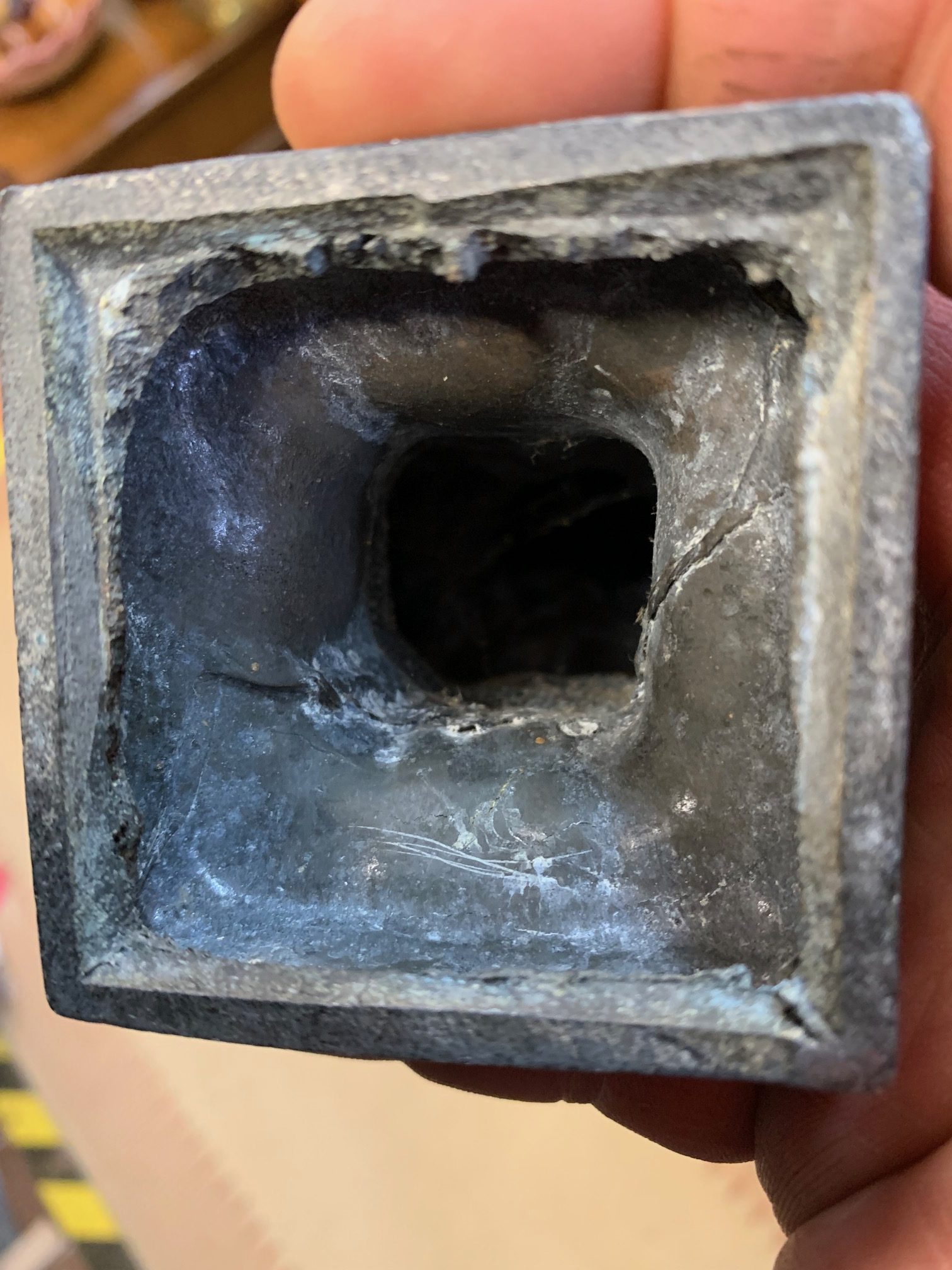
Identifying Bronze vs Spelter, and how they differ in their appearance and handling
Often, Spelter is painted to give a Bronze appearance, meaning when looking comparatively at both a Spelter and Bronze statue, it can be difficult to tell them apart.
- Weight is only an indicator, not a reliable test, of whether a statue is made of Bronze or Spelter. While Bronze may sometimes be heavier as the alloy contains a large amount of copper, which is a heavier metal than zinc and tin, some spelters contain lead, which is a relatively heavy metal. Both Bronze and Spelter are cast hollow in larger sizes, making the weight harder to tell apart. Also, the weight of cast metals may be more down to the casting techniques used by a given Bronze Foundry or metal caster. Some casters simply cast metal thicker! However, smaller bronzes are often cast solid, which has likely given rise to this slightly misleading technique of identification of Spelter and Bronze by weight in the antiques market. And beware of bases, as their weight may prevent reliably comparison the weight of a statue in the hand (stone bases like granite and marble are heavier than wood).
- The main giveaway between the two is their base metal colours. If you were to do the scratch test on a discreet part of a Spelter statue, underneath you would reveal a silver or grey colour, due to the high Zinc content. If you were to do the same for Bronze, you would see a yellow or gold colour due to the high Copper content. (If you have a sculpture that you are trying to differentiate, the best place to scratch the surface is usually the base of the statue, this may be covered by felt, or a base, which can be removed and reattached with care in the case of the base, or replaced or re-stuck in the case of the felt).
- Colour can indicate Bronze or Spelter, as Bronze statues often have a red gold or brown gold, potentially olive bronze or green verdigris colour. Spelter often has a lighter, less ‘warm’ more silvery colour. However, there are many different colours of Bronze patina, and Spelter patina or paintwork, so this is not a reliable test. With Bronze, the patina develops over time as a result of the Copper reacting to the environment around it, and the artifical patina chemical composition reacting to the environment. This patina can help protect the material (along with waxing). Spelter does not develop a natural patina over time, so without this additional protection corrosion may be more evident. Though it is important to note that Spelter statues are often painted to look more akin to Bronze, or are artificially patinated to look similar, or are electroplated with a very thin layer of bronze.
- Depth and attractiveness of detail may be an indication of Bronze rather than Spelter. The relative cheapness of Spelter makes is more likely to have been used for cheaper designs, where detailing may be badly defined. Meanwhile, successful sculptors are often attracted to stronger, more beautiful, but more expensive materials like Bronze, so the sculpting quality may be higher, along with the casting quality. Antique Bronzes and Spelter statues can sometimes be separated by a smoother finish on the Bronze, but only within the smoother sculpting styles or sculptural movements, this does not apply to more textured style – and there are some very good Spelter statues in the smoother style.
- The base of a statue, if visible, may indicate the thickness of the wall of the casting. A thin casting may indicate Spelter, instead of Bronze. But this is deceptive, as some Bronzes is cast thin. Also the wall of many castings (in either material) may widen at base, so that the visible edge is not actually the true thickness of the material above; see the Spelter statue base photo to the left. Be wary, as casting thickness also varies a huge amount throughout a sculpture. Finally, a plated bottom may prevent you from seeing the casting thickness.
- As a stable material Bronze tends to maintain its colour consistency over time, especially when well looked after and cared for correctly. For more information, see Tanya’s article on how to correctly care for a bronze statue. While Spelter can experience more inconsistencies over time, in regards to colour and texture, depending on the alloy makeup of that specific statue.
- If your sculpture has cracks, it is more likely to be Spelter, as Bronze is stronger and more durable. However, Bronze can also crack with mishandling. Check to see if damage has revealed the material colour inside. Note the
- If your statue has a peeled or chipped surface coating, suggesting paint, it is more likely to be Spelter, not Bronze.
Do Bronze and Spelter Rust?
Rust can only occur in metals that contain iron, therefore Bronze (a Copper and Tin alloy) and Spelter (a Zinc and Lead alloy) can not rust. This does not mean they can’t experience corrosion, however, which is explained further “Longevity in Bronze vs Longevity in Spelter” below.
Longevity in Bronze vs Longevity in Spelter
Like any material, there are best practices to keep something in the best condition possible, however, there are notable differences in the longevity between Bronze and Spelter from the offset.
- Bronze is renowned for its durability and robustness in many indoor and outdoor environments
- It has been used for centuries in the creation of culturally significant artworks, and much of it has lasted until now. Spelter is a relatively modern material, which due to its relative fragility is unlikely to last as long, though the Art Deco / Art Nouveau is still popular
- Bronze can be damaged, but with regular upkeep and proper care can last indefinitely
Bronze actually develops a protective, desirable patina in over time, after its exposure to environmental elements - Bronze can, very rarely, suffer with a condition called “bronze disease”. This however, only tends to affect historical artefacts that have had contact with water, such as those retrieved from a shipwreck, for example
Spelter, however due to being a softer, more brittle metal than Bronze, means it is more prone to wear and tear, even with care and upkeep.
- Zinc, the main metal in Spelter, typically offers good corrosion resistance if kept in non harsh environments
- Spelter’s properties do make it significantly more susceptible to corrosion and damage from environmental factors, such as sunlight and extreme temperatures
- Repairing Spelter via welding is often inadvisable as it risks damaging a large part of the statue irreversibly. It is often fixed using epoxy resin and internal bracing in the cavity.
- To ensure longevity on your Spelter sculpture, it is best cared for and utilised as an indoor statue
It is important to remember that even for the most durable of metals, such as Bronze, maintenance and regular upkeep of your statue is best practice to ensure the longevity and quality of your piece.
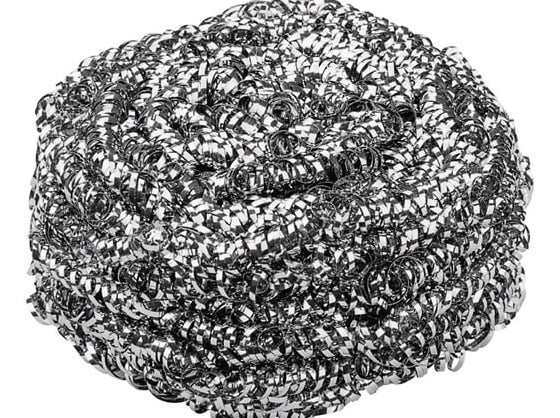
Above left: Avoid abrasive cleaning tools and chemicals, which may irreversibly damage your Bronze or Spelter statue.
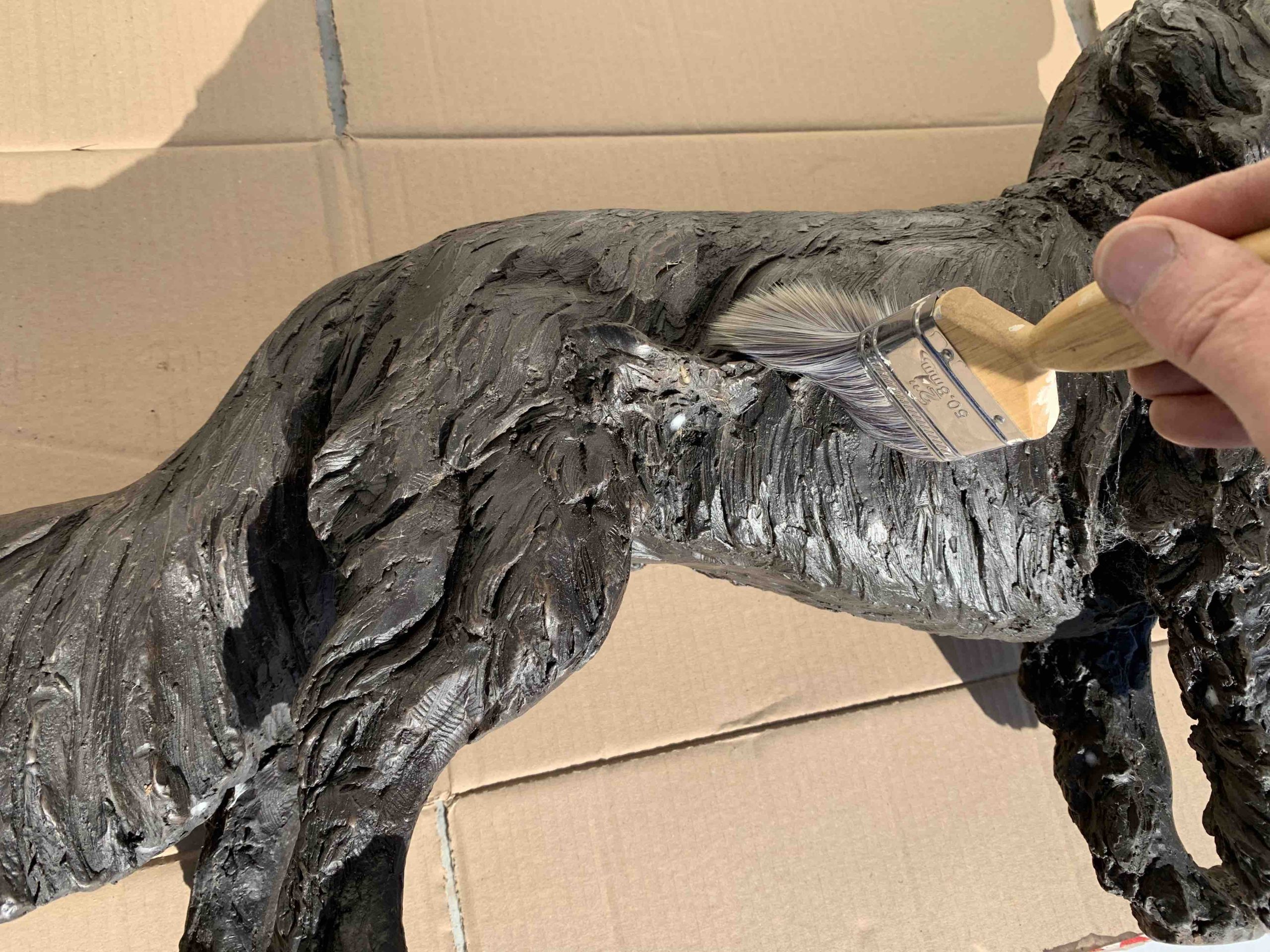
Above right: Use soft cleaning tools, water, and approved waxes to maintain your sculpture.
The cost of Bronze vs the cost of Spelter
It is important to consider their differences to understand their price points, which can come down to a number of factors.
Important factors to consider, when considering both metals are:
- Material Cost: Immediately evident is the higher cost associated with Copper (in Foundry Bronze) when compared to Zinc (in Spelter). Consequently, artworks created from Bronze tend to command a higher price than those crafted from Spelter.
- Craftsmanship: The traditional method for making Bronze statues is “The Lost Wax Method”, which is an incredibly detailed and skilled process. Alongside the incredible craftsmanship required, this method is able to capture incredibly intricate, delicate details, which can as a result, provide a more emotive piece. Whilst Spelter can be used to express a variety of things, it may not offer the same intricacies as Bronze, thus making Bronze more expensive
- Perceived Value: For most people looking for a sculpture, Bronze is considered an excellent choice due to its incredible durability, and its ability to hold its worth over many years. These qualities make Bronze highly collectable adding to its perceived value. Antique Spelter artwork, can too, be highly sought after due to its historic context.
- Size: The size of the artwork can affect the overall cost of a piece. When making large statues, or even a big commission piece, Bronze is the go-to choice for artists, meaning the increased use of materials to make it will make the price more substantial. Spelter is rarely used for large works of art, meaning a lower price point
- Collectibility: While both Bronze and Spelter artworks hold historical significance and are sought after, several factors influence their pricing. The condition of both Spelter and Bronze plays a role in determining their respective costs. Notably, Bronze statues often exhibit better preservation due to their inherent ability to withstand diverse environments and the test of time. Additionally, other considerations include the artist, time period, and rarity, all of which contribute to the overall expense.
Credits to others: The non-bronze sculpture imagery on this page is courtesy of Black Lion Antiques, Llandovery, Wales.
Above left: There are many misleading video guides, some from experts, on the differences between Spelter and Bronze. This is one of the better ones:
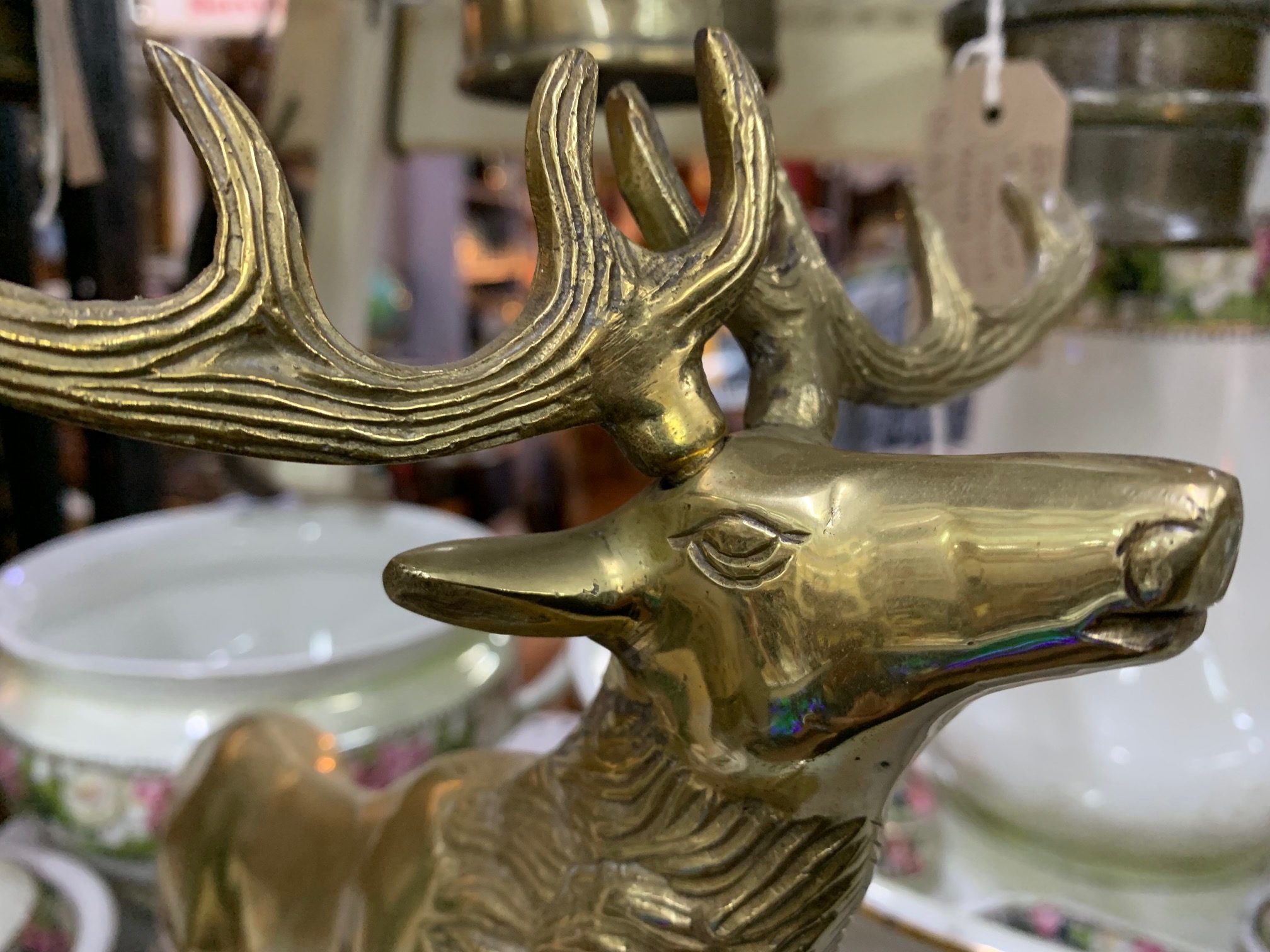
Above right: A Brass stag. Spelter is only one of many different metal alloys used for statues, though it is one of the closest imitations.
Caring for Bronze vs Spelter
As different material, which are normally finished in a different way, the care and maintenance of Bronze and Spelter are different.
- Attempting to maintain a statue in the wrong way can cause damage, which may be irreversible.
- The most reliable care methods are those recommended by the original artist, or manufacturer, if they can be found.
- Neither Bronze nor Spelter should not be abraded using abrasive brushes, wire wool, or cloths. Many cleaning tools are made of stronger metals than either Bronze or Spelter, such as Steel, which will destroy Bronze patina and Spelter patina or paintwork, and scratch the metal alloy beneath.
- Do not use any cleaning chemicals on Bronze or Spelter, including homemade cleaning agents.
- Softer cleaning methods such as dusting with a soft cloth and clean paintbrush, or cleaning with water and a soft cloth and drying with a soft towel are appropriate for Bronze. I do not make Spelter and you should seek your own care advice: Spelter is even more likely to be marked when cleaned inappropriately, so at first you should avoid rubbing, even with your soft cleaning tools, which could theoretically damage a corroded Spelter statue, or or one with a delicate finish.
- Waxing is one of the most sympathetic methods of restoring a protective coating, however, the best waxes to use are those frequently used for caring for sculpture (such as Renaissance wax). I use Black Bison wax. Many waxes, such as car wax, contain chemical agents that may harm a statue.
- Bronze repair should be conducted by a Bronze Foundry. Spelter repair can be conducted by a manufacturer or restorer – Spelter is frequently repaired using an epoxy resin, due to the difficulty of welding the thin zinc-alloy.
- Both Bronze and Spelter can be gilded, and repairing gilding is also a task for a specialist.
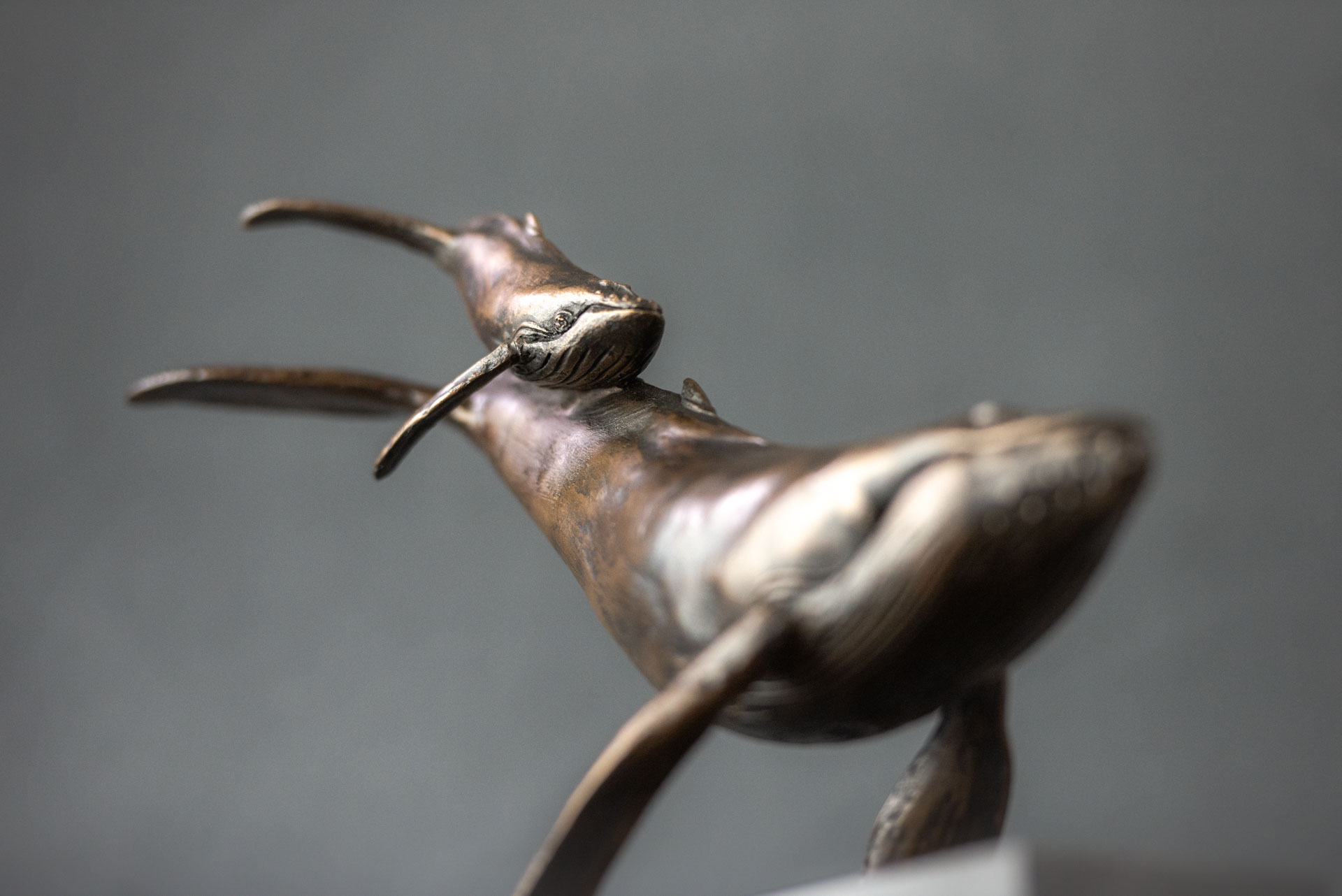
To Conclude
In conclusion, while Spelter may not command the same level of desirability or long-term value as bronze, it possesses inherent worth due to its rich historical context, exquisite craftsmanship, and undeniable beauty.
Throughout our comparison of the physical differences between Spelter and Bronze, we have highlighted Bronze’s natural advantages in terms of durability, environmental resilience, and value retention. However, it is crucial to think deeper and acknowledge that, in the realm of creativity and the subjective nature of art, you are unable to directly compare Spelter and Bronze. Beyond comparing their physical properties, what makes each truly special is their uniqueness, fundamentally mirroring the individuality in the artistic creations they embody.
Explore Related Articles
Drawing inspiration from life – Folly Farm’s Hugo the Lion
Hugo was a magnificent lion – and a lovely example of how inspiration can be drawn from life for sculpture where possible.
ASTON VILLA F.C. unveils my Lion to celebrate their 150th year
Due to be unveiled in May, I have created a to scale clay, which is now being cast in Foundry Bronze metal
How to measure your dog in a Lying Down pose, for a customised statue commission
If you think you might want a statue in the future, it can be a good idea to take some measurements of your own dog. Here’s how to measure them in a lying down position.

Tanya Russell MRBS
Bronze Sculptor
Tanya Russell has become well known over the last 30 years for her life-like and vibrant animal sculptures.
Having apprenticed for 7 years with her parents, sculptors Lorne McKean FRBS and Edwin Russell FRBS and after practicing as a sculptor for a number of years, she founded the The Art Academy in London Bridge, now a thriving art college. She has completed many public and private commissions nationally and internationally.
For Tanya, her practice is not only about capturing the animals she sculpts with marks and movement. It’s about our relationships with those animals and their welfare.


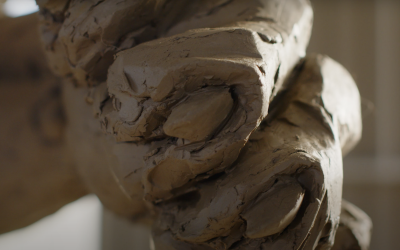
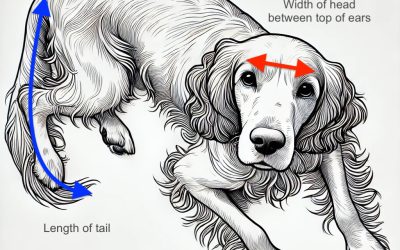
Follow The Artist
Keep up to date with Tanya's latest work!